A study from the University of Cambridge found that kids’ money habits – will they be conservative savers or profligate spenders? – are formed by the time they’re seven years old. All the more reason to teach our kids about money management, personal finances, and the economy.
Table of Contents
For the Grown-Ups
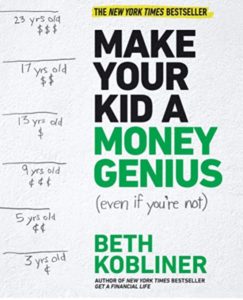 |
Beth Kobliner’s Make Your Kid a Money Genius (Simon and Schuster, 2017) is a parents’ guide for teaching kids from preschool to young adulthood about money management. It’s not all about money; it’s also about such values as delaying gratification, working hard, thrifty living, and generosity toward others. |
|
Debit cards for kids? Advantages include building financial responsibility and a good credit score; disadvantages – if improperly managed – include the risk of a less-than-responsible kid spending a lot of money. Recommended is the Greenlight card, with apps which allow parents to set spending limits, transfer allowance money, and pay for completion of specific chores. From The Balance, see The 7 Best Debit Cards for Teens and Finder’s 5 Best Debit Cards for Kids. |
Money: Fiction
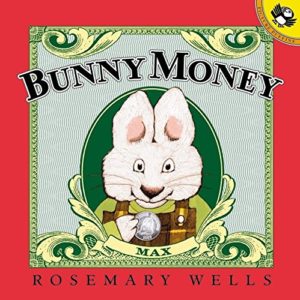 |
In Rosemary Wells’s Bunny Money (Puffin, 2000), Max and Ruby can’t agree on a birthday gift for their grandma – Ruby votes for a ballerina box; Max for vampire teeth – but some disastrous money management leads to trouble. For ages 3-6. |
 |
In Emily Jenkins’s Lemonade in Winter (Schwartz & Wade, 2012), Pauline and John-John – even though it’s freezing outside – come up with a plan for selling lemonade and limeade. Simple math and money concepts for ages 3-7. |
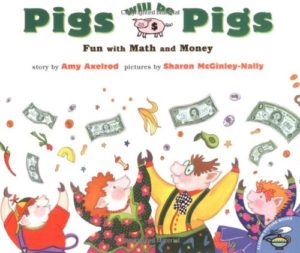 |
In Amy Axelrod’s Pigs Will Be Pigs (Aladdin, 1997), there’s not food in the house so the pig family wants to go out to dinner – but they have no money. And so they comb the house, unearthing coins and bills (and adding them up along the way). For ages 5-8. |
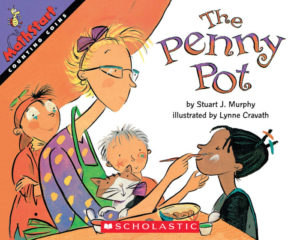 |
One of the MathStart series, Stuart J. Murphy’s The Penny Pot (HarperCollins, 1998) is a picture-book exercise in coin-counting as kids try to come up with fifty cents at a face painting booth. For ages 5-8. |
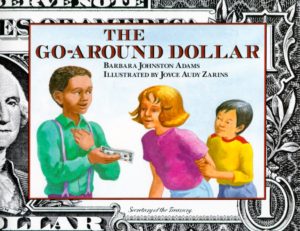 |
In Barbara Johnston Adams’s The Go-Around Dollar (Simon and Schuster, 1992), Matt finds a dollar on his way home from school and uses it to buy shoelaces from Eric. Eric then uses the dollar to buy bubblegum; and Jennifer – the next customer in line – gets the dollar as part of her change. On and on the dollar goes until it finally ends up in a frame, as the first dollar earned at the opening of a new store. Included are facts and information about dollar bills. For ages 4-8. Want to track a dollar bill? Check out the Where’s George project. |
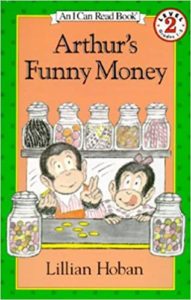 |
By Lillian Hoban, Arthur’s Funny Money (HarperCollins, 1984) – an I Can Read Level 2 book – is the story of Arthur’s struggle to earn enough money to buy a T-shirt and cap, with help from his sister Violet. (“Well,” said Violet, “if I have five peas and you take three and give me back two, how many peas will I have?” “All of them,” said Arthur. “I don’t like peas.”) For ages 4-8. |
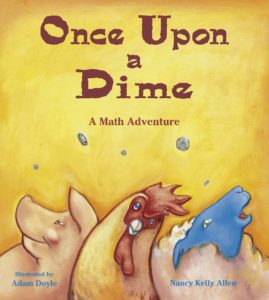 |
In Nancy Kelly Allen’s Once Upon a Dime (Charlesbridge, 1999), a little tree on organic farmer Truman Worth’s farm begins sprouting money – beginning with a crop of shiny pennies. For ages 4-8. |
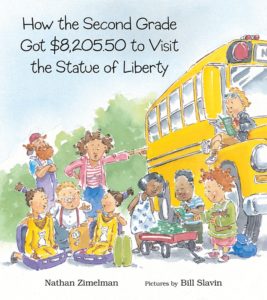 |
In Nathan Zimelman’s How the Second Grade Got $8,205.50 to Visit the Statue of Liberty (Albert Whitman & Company, 2017), class treasurer Susan Olson – listing their sometimes hilarious experiences under “Expenses” and “Profit” – details all the money-raising projects the class devises for their trip to the Statue of Liberty. For ages 4-8. |
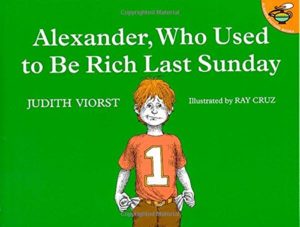 |
In Judith Viorst’s Alexander, Who Used to Be Rich Last Sunday (Simon and Schuster, 1995), Alexander is given a dollar by his grandparents – but soon fritters it away on disastrous choices, including a hour’s rental of a friend’s pet snake. For ages 4-8. |
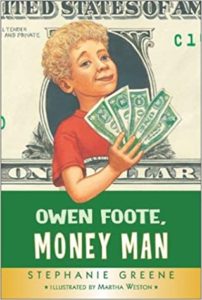 |
In Stephanie Greene’s Owen Foote, Money Man (Clarion, 2003), Owen – hooked on a catalog of desirable “Junk You Never Knew About” – wants to make money and so comes up with one dreadful money-making scheme (try toilet demonstrations) after another. Things only begin to improve when he changes his ideas about how to earn and spend money. For aged 7-10. |
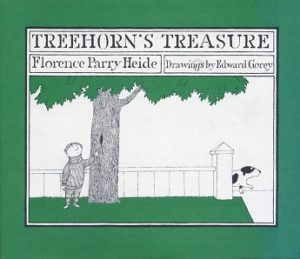 |
In Florence Parry Heide’s Treehorn’s Treasure (Pomegranate, 2011) – illustrated by Edward Gorey – Treehorn discovers that the tree in his yard is sprouting dollar bills, but his clueless parents refuse to pay attention. Treehorn is priceless. For ages 8 and up. |
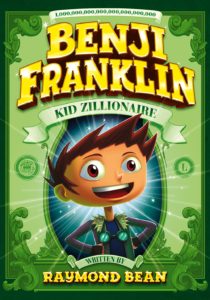 |
Raymond Bean’s Benji Franklin: Kid Zillionaire (Capstone, 2015) is the first of a series about twelve-year-old Benji, a creative genius who invents an excuse-gnerating app and becomes the world’s first zillionaire. Subsequent titles include Investing Well (In Supersonic Spaceships), Buying Stocks (And Solid Gold Submarines), and Saving Money (And the World from Killer Dinos). Fun for ages 7-11. |
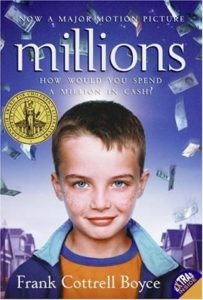 |
In Frank Cottrell-Boyce’s Millions (Macmillan, 2019) is a British delight. Damian and Anthony Cunningham – respectively obsessed with saints and house prices – find a sack of two million pounds – and have just seventeen days to spend it before the British pound converts to the euro. Damian wants to help the poor; Anthony has other ideas – and there are thieves who just want the money back. For ages 8-12. |
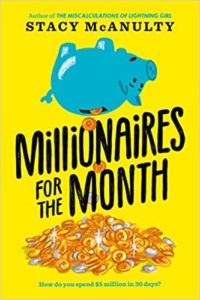 |
In Stacy McAnulty’s Millionaires for the Month (Random House, 2020), Felix and Benji on a class trip find the lost wallet of billionaire Laura Friendly – from which they abstract $20 to buy themselves lunch. Friendly therefore lands the boys with a challenge: spend $5 million in 30 days. It’s much harder than it sounds. For ages 9-13. |
Money: Nonfiction
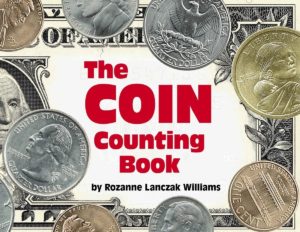 |
Rozanne Lanczak Williams’s The Coin Counting Book (Charlesbridge, 2001) is a rhyming introduction to money from pennies to dollar bill, illustrated with photos. For ages 4-7. |
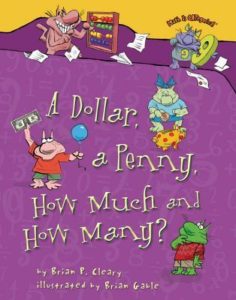 |
Brian P. Cleary’s A Dollar, a Penny, How Much and How Many? (Millbrook Press, 2014) is a humorous introduction to money for ages 4-8, with wacky cartoon illustrations. |
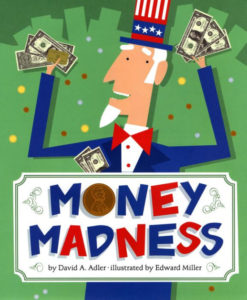 |
By David A. Adler, Money Madness (Holiday House, 2009) is a simple picture-book introduction to money concepts for ages 4-8. |
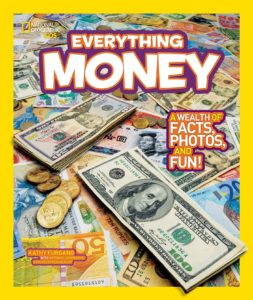 |
Kathy Furgang’s Everything Money (National Geographic, 2013) is packed with gorgeous photographs, kid-friendly information, and catchy facts about the history, use, and effects of money. An appealing introduction for ages 8-12. |
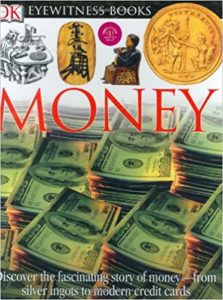 |
Joe Cribb’s Money (DK, 2016) in the popular Eyewitness series covers the story of money from silver ingots to credit cards. Each double-page spread, illustrated with drawings, graphics, and wonderful photos of artifacts, covers a different money-related topic, among these “The first coins,” “The first paper money,” “Money and trade,” “Money in war,” and money from a wide range of different countries. For ages 8 and up. |
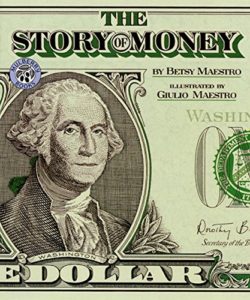 |
In Betsy Maestro’s The Story of Money (HarperCollins, 1995), readers learn about the many different forms money has taken around the world and through history. For ages 6-10. |
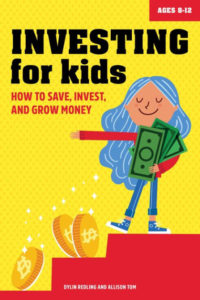 |
By Dylin Redling and Allison Tom, Investing for Kids (Rockridge Press, 2020) is a beginner’s guide to earning, saving, investing, risk, stocks and bonds, and financial planning for ages 8-12. |
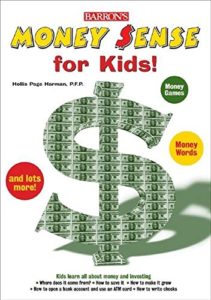 |
By Hollis Page Harman, Money Sense for Kids (Barron’s, 2004) covers the anatomy of bills (who’s on what? And what do all those symbols mean?), how money travels from mint to bank to consumer, earning, saving, and investing, stocks and bonds, and more, with activity suggestions. For ages 9-13. |
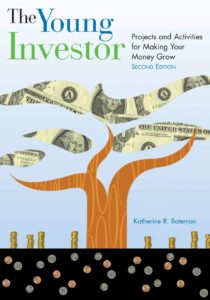 |
Katherine R. Bateman’s The Young Investor (Chicago Review Press, 2010) covers the basics of money, how saving works, simple and compound interest, stocks and bonds (and how to buy and sell them), mutual funds, inflations and recession, the function of the Federal Reserve, how mortgages work, and more. Included are many projects and activities; kids, for example, learn to balance a checkbook and read a stock table. For ages 9 and up. |
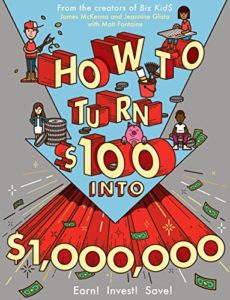 |
By James McKenna, Jeannine Glista, and Matt Fontaine, How to Turn $100 into $1,000,000 (Workman, 2016) may not immediately rocket you to millionaire-dom, but it is filled will helpful and conversational information on financial goals, budgets, jobs, starting a business, savings, compound interest, and more for ages 10 and up. |
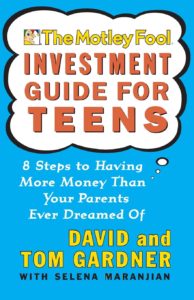 |
By David and Tom Gardner, The Motley Fool Investment Guide for Teens (Touchstone, 2002) is a witty and informational guide to investment and money management. The subtitle is “8 Steps to Having More Money Than Your Parents Ever Dreamed Of.” The authors suggest that kids start now. For ages 13 and up. |
 |
Visit the United States Mint Kids Site for games and activities, information on coins and coin collecting, coin programs and scout badges, and more. |
|
A sobering look at money. Check out the U.S. Debt Clock. |
